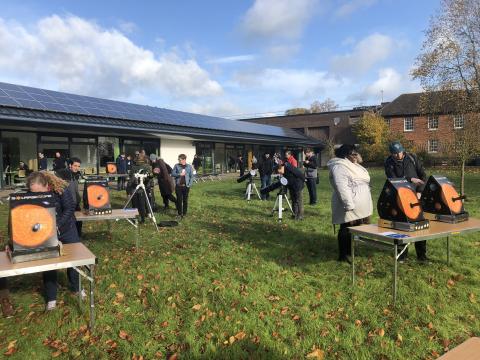Mercury Transit

On Monday 11th November 2019 over 100 Walton Hall based staff and students got a chance to view a rare astronomical event, the passing of the planet Mercury across the Sun’s disk. Organised by SPS PhD student, Jack Wright, observers battled the bitterly cold weather on the Mulberry Lawn on the OU campus with six solar viewers, two telescopes with white light solar filters, and one H-alpha telescope allowing the Sun to be viewed safely.
In addition, science talks were offered in the Hub Lecture Theatre by SPS PhD students David Pegg, Chris Malliband and Zoe Morland who did a fantastic job of introducing the geology of the planet Mercury, and explained more about the transit itself.
The previous transit of Mercury was in 2016 and a similar OU event was held then, but the next transit is not until 2032. Transits of Mercury occur in May and November when Mercury, the Sun, and Earth are aligned, and the orbital planes intersect. Even still, this alignment only happens about 13–14 times a century. Historically, transits have been used to measure the parallax of the Sun (i.e., to determine the Earth–Sun distance). This allowed for estimates of the scale of the Solar System. In modern times, transits are useful experiments for estimating the light level drop that might accompany a transit of an exoplanet across its parent star.
A huge thanks to the volunteer team that helped make this a successful event: (SPS) David Pegg, Chris Malliband, Narissa Patel, Ben Man, Megan Brown, Zoe Morland, Heidi Thiemann, and Dave Rothery. (EEES) Alvaro Del-Moral-Jimenez, Kate Hand, Carrie Walker, Stacy Phillips, and Bea Baharier. In addition, advice for the event was given throughout the planning stage by Andrew Norton. Natalie Starkey helped promote the event.
.jpg)
